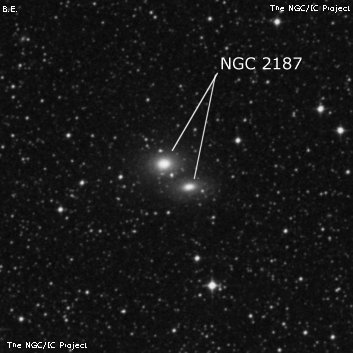
John Herschel discovered NGC 2187 = h3025 on 23 Dec 1834 and recorded a "Double nebula, position 12.5 degrees; larger pB, R, gbM, 40"; smaller vF, R, glbM." His position (measured on 3 sweeps) corresponds with the double system ESO 57-68A. On the other two sweeps he only recorded seeing a single object. He called it double in the General Catalogue, although only a single designation was assigned.
Joseph Turner sketched the pair with the the Great Melbourne Telescope on 13 Dec 1878, as well as Pietro Baracchi on 3 Jan 1886. The brighter NE galaxy was shown with a small bright nucleus and the SW galaxy has a smoother surface brightness. Barrachi assumed the companion was a new discovery, although John Herschel probably deserves credit.
600/800mm - 24" (4/11/08 - Magellan Observatory, Australia): although described as a "double nebula" by John Herschel, this close pair of galaxies received a single NGC entry. At 260x the fused pair is oriented SW-NE with their outer halos overlapping. The brighter northeast component was fairly bright, fairly small, round, 35" diameter, strong concentration. The southwest member was between fairly faint and moderately bright, fairly small, slightly elongated E-W, 40"x35", weak concentration, with the lower surface brightness of the pair. This duo shines through the eastern portion of the LMC.
Notes by Steve Gottlieb